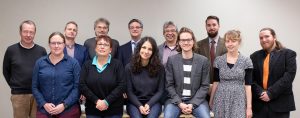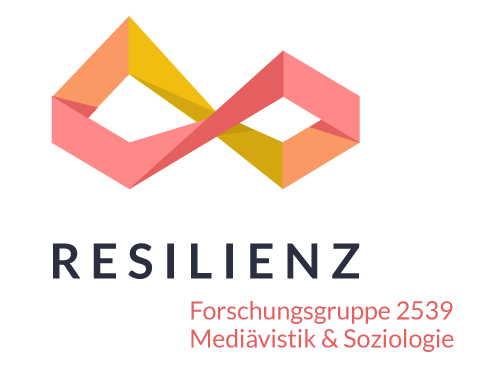
The project leader and staff of the second funding period (from top left to bottom right): Christoph Cluse, Benjamin Rampp, Martin Endreß, Thomas Rüfner, Lukas Clemens, Sebastian Weiß, Anne Diblik, Rita Voltmer, Tania Günther, Lars Grimm, Annika Funke, Julian Lechner (missing: Lisa Dünchem).
Programme (2nd Funding Period)
The Fundamental Idea and Starting Point
In the second funding period (1 October 2019-30 September 2022) the research group will build on the findings and achievements of the first funding period, and continue this work with a view to the concepts that have proven to be analytically beneficial and develop them further. At the same time their theoretical and empirical focus will be complemented. Research during the second funding period will especially focus on analysing the connections between phenomena of continuity and discontinuity in socio-historical processes, and on the significance of disruptive phenomena. Furthermore, the research group extends its temporal investigation interest to the 15th-17th century. This broadening of the focus corresponds to and serves the superordinate research interest of the research group, which is connected with the testing of the resilience concept for the historical and social sciences, to examine established notions of epochal divisions and boundaries as well as common constructs such as that of the „late medieval times of crisis“ and, in general, those of „crisis“ or „change“, and to critically question them with regard to their analytical potential.
Priority-Setting
In the second funding period, the work of the research group will focus even more strongly than in the first period on cross-project thematic focal points in the analysis of the investigated resilience processes:
- In terms of content, the project work will focus on examining the groups of actors involved. Actors and actor constellations on different levels of analysis will be looked at, which, in the sense of the concept of the panarchy (see below) and the research group’s interest in multi-level dynamics, feature various interactions that are to be investigated.
- One of the projects focal points are the practices and typologies of leadership and representation used, for example by communities, networking or elites. Here, especially resilience strategies and their (secondary) consequences, which are always linked back to the structuring resilience dispositions and activated resilience resources, are examined.
- Another focus is on the area of law, justice and security. Therefore, the projects take up the question of how to deal directly with disruptive challenges. They tie in with the use of the concept of resilience in political and other sciences, but complement this perspective on the one hand by a broader understanding of challenges and on the other hand by analysing the socio-cultural and socio-economic contexts framing the respective socio-historical resilience processes.
These focal points are linked on one hand by concentrating on the groups that make observable use of resilience processes. This is intended to compensate and overcome the structural-theoretical narrowing of the resilience analytical models consulted. On the other hand the projects will concentrate on patterns of interpretation in the sense of first order constructions (Husserl, 1989) of these groups considering a basic social-constructive perspective. The priorities are considered by further narrowing the focus of the projects that are continued in the second funding period (projects 1, 2, 5) and by further specifying and complementing the research group’s composition by adding two new projects (projects 3, 4) (to the projects of the second funding period).
Cross-Project Issues
In the second funding period, the research group will address the following questions, challenges and tasks:
- The research group will focus even more strongly on the connection between phenomena of continuity and discontinuity – or in other words: between stability and change or routine and crisis – as a central issue. The research group does not see this connection as a paradoxical contradiction, but rather wants to investigate how socio-historical continuities depend on discontinuities and in which way they may result from continuities.
- In the second funding period, the projects will each focus exemplarily on one disruptive phenomenon that is central to the respective empirical case – or, in a socio-constructive perspective: on a corresponding identification – and thus create an even stronger comparison between the projects. A dual socio-constructive approach will be pursued by focusing on the question of perspective: (1) with regard to first-order construction processes and perceptions by the empirically investigated socio-historical actors and (2) with regard to second-order construction processes.
- The research group will put an even stronger focus on the mediation between action and structural theory perspectives that is made possible by the resilience concept in the course of the analytical linking of resilience strategies, dispositions and resources.
- In order to investigate the relationship between phenomena of

Source: Raford 2010 (http://noahraford.com/?p=648); Holling 1987: 145; Gunderson/Holling 2002: 34
continuity and discontinuity, the research group will further examine the analytical utility as well as the further development and adaptation of the resilience analytical models of the Adaptive Cycle and Panarchy (see right).
- Of particular interest for the research group is the question of regime change of social units in the context of transformation dynamics. The research group will also deal with the adequacy of the „cycle“ metaphor of the resilience-analytical models by using a systematic approach.
- In order to provide a more detailed view of the specific (typological) relationship between resilience strategies, resilience dispositions and resilience resources, the research group will differentiate more explicitly between internal and external factors of vulnerability – though this differentiation in the sense of the research group’s anti-essentialist perspective is always to be understood as the result of processes of perception and social construction.
- Aligned with the stronger focus on central disruptive phenomena, the research group will also take a more decisive look at transition and acceleration points in order to enable comparative (typological) analyses of the course of resilience processes and their modes. This should consider the difficulty of differentiating between processes of adaptation (understood as change within already known trajectories) and those of transformation (understood as change that opens up new paths of development) identified in the first funding period.
